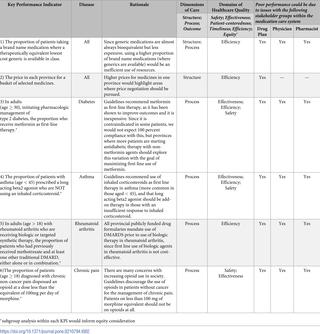PLOS ONE ( IF 2.9 ) Pub Date : 2019-01-15 , DOI: 10.1371/journal.pone.0210794 Eldon Spackman 1 , Fiona Clement 1 , G Michael Allan 2 , Chaim M Bell 3 , Lise M Bjerre 4 , Dave F Blackburn 5 , Régis Blais 6 , Glen Hazlewood 1, 7 , Scott Klarenbach 8 , Lindsay E Nicolle 9 , Nav Persaud 10 , Silvia Alessi-Severini 11 , Mike Tierney 12 , Harindra C Wijeysundera 13, 14 , Braden Manns 1, 7

|
Objective
To develop key performance indicators that evaluate the effectiveness of a prescription medication system.
Methods
A modified RAND/UCLA appropriateness method was used to develop key performance indicators (KPIs) for a prescription medication system. A broad list of potential KPIs was compiled. A multidisciplinary group composed of 21 experts rated the potential KPIs. A face-to-face meeting was held following the first rating exercise to discuss each potential KPI individually. The expert panel undertook a final rating of KPIs. The final set of KPIs were those indicators where at least 80 percent of experts rated the indicator highly i.e. rating of ≥ 7 on a scale from 1 to 9.
Results
292 KPIs were identified from the published literature. After removing duplicates and combining similar indicators 71 KPIs were included. The final ranking resulted in six indicators being ranked 7 or higher by 80% of the respondents and an additional seven indicators being ranked 7 or higher by ≥70 but ≤80% of respondents. The six selected indicators include four specific disease areas, measure structural and process aspects of health service delivery, and assessed three of the domains of healthcare quality: efficiency, effectiveness, and safety.
Conclusions
These indicators are recommended as a starting point to assess the current performance of prescription medication systems. Consideration should be given to developing indicators in additional disease areas as well as indicators that measure the domains of timeliness and patient–centeredness. Future work should focus on the feasibility of measuring these indicators.
中文翻译:

制定处方药系统的关键绩效指标
客观的
制定评估处方药系统有效性的关键绩效指标。
方法
使用改进的兰德/加州大学洛杉矶分校适当性方法来开发处方药系统的关键绩效指标 (KPI)。编制了一份广泛的潜在 KPI 清单。由 21 名专家组成的多学科小组对潜在的 KPI 进行了评估。第一次评级活动后举行了一次面对面会议,分别讨论每个潜在的 KPI。专家组对KPI进行了最终评级。最终的 KPI 集是至少 80% 的专家对该指标给予高度评价的指标,即在 1 到 9 的等级中评分≥7。
结果
从已发表的文献中确定了 292 个 KPI。删除重复项并合并类似指标后,纳入了 71 个 KPI。最终排名结果显示,有 6 个指标被 80% 的受访者评为 7 或更高,另有 7 个指标被≥70但≤80%的受访者评为 7 或更高。选定的六项指标包括四个特定疾病领域,衡量卫生服务提供的结构和流程方面,并评估医疗保健质量的三个领域:效率、有效性和安全性。
结论
建议将这些指标作为评估处方药系统当前性能的起点。应考虑制定其他疾病领域的指标以及衡量及时性和以患者为中心的指标。未来的工作应重点关注衡量这些指标的可行性。











































 京公网安备 11010802027423号
京公网安备 11010802027423号